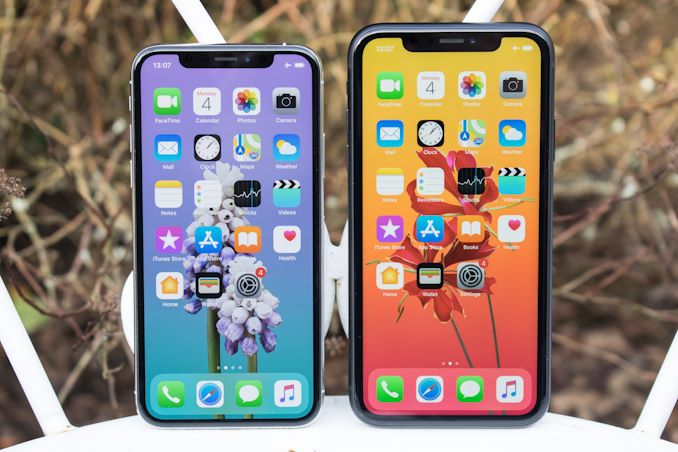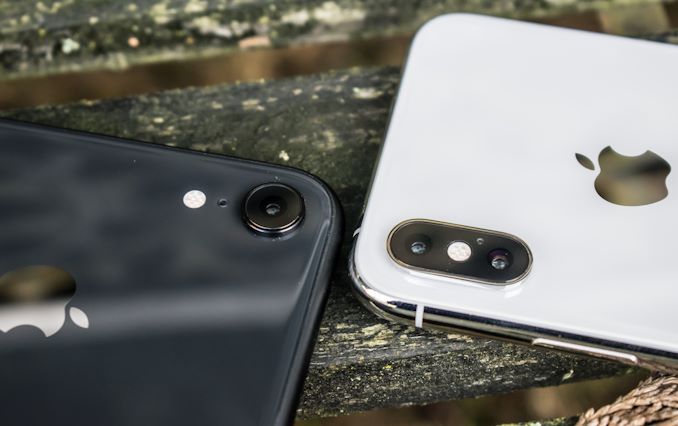The Apple iPhone XR Review: A Different Display Leads To Brilliant Battery Life
by Andrei Frumusanu on February 5, 2019 9:45 AM EST- Posted in
- Mobile
- Apple
- Smartphones
- iPhone XR
Conclusion & End Remarks
The iPhone XR is an interesting phone for Apple simply because of its price positioning. Starting at $749, it’s $250 cheaper than the base iPhone XS, and $350 cheaper than the iPhone XS Max. And this is a gap that continues straight up to the max capacity 256GB models. So the big question here for most users is if the iPhone XR’s differences represent reasonable compromises for the lower price.
From a design standpoint, the iPhone XR comes in the same industrial design as the iPhone XS variants – both of which follow up on the previous generation iPhone X. The big difference here is in the bezels, which are notably larger on the iPhone XR. It does not represent any deal-breaker for the phone and it’s something that I guess most users will get used to – but my gripe is still that with a $749 price tag, the design feels more like something that would have come from a budget smartphone. Apple’s choice of insisting on a symmetric bezel design isn’t something that I personally find appealing in this implementation – but I do know some other users prefer this kind of design over asymmetric bezels (though you could argue the notch makes it asymmetric anyhow…).
The one thing that surprised me the most when using the iPhone XR is that even though it’s a smaller phone than the XS Max, it doesn’t always actually feel all that smaller. Here the increased thickness of the phone does change the in-hand feel quite a lot, and it will feel bigger than you’d expect for a phone with its 75.7mm width.
The main (and most visible) difference between the XR and its XS is inarguably the screen. Among the reasons Apple is able to offer the XR at a cheaper price point is eschewing an OLED panel in favor of a more traditional LCD. In terms of the fundamentals of the LCD in the iPhone XR, Apple continues to employ some of the best panels in the industry, and the iPhone XR is no exception to this. Brightness, contrast ratio (for an LCD), viewing angles, and colour calibration are all top-notch and will not disappoint.
The one area where I think Apple went too conservative is with the display resolution. For the majority of users this will be a subjective matter and it will depend on how they use their phones, but I personally found it among the larger compromises made, and something that would be a deciding factor for me to opt against getting the XR. For anybody else who never use their phones closer than at arm’s length or are less sensitive to the resolution difference, it should not represent any major drawback.
With that said, Apple’s choice to go with an LCD display has a very important side-effect for the iPhone XR: because it avoids the double-edged sword that is a higher-end OLED, it also avoids the technology's higher base power consumption. This increased base power consumption was the reason why the XS Max lasted a notably shorter period of time than the iPhone 8 Plus. The iPhone XR avoids this problem, and in conjunction with the fantastic A12 SoC, the phone is able to achieve Apple’s best ever battery results in our tests. Lasting 25% longer than the iPhone XS Max, this represents a major improvement in battery life and is going to make all the difference for users who value it above everything else. For those users, the cheaper iPhone XR may very well be the better choice.
The performance of the iPhone XR is very much in line with the XS – meaning you’ll be getting an industry leading experience. An important factor for users who value gaming a lot is that, as a side-effect of the lower-resolution screen, the iPhone XR gets better GPU performance and better power efficiency as the phone is only pushing 44% of the pixels of the XS Max. This means longer gaming battery runtimes in current games, and better experiences in future, more demanding games.
The camera on the iPhone XR is pretty straightforward: It’s the same fantastic experience as on the iPhone XS, with the only difference being that it lacks the telephoto lens. Apple’s strengths here are their absolutely great capture experience, which is among the most consistent of current generation smartphones, as well as class-leading picture quality that ties with the best of the competition. Low-light performance is good, but as was the case with the XS, the Android handset vendors have seen immense jumps over the last year due to their usage of computational photography and better sensors, and it’s something that Apple just currently lags behind at.
The lack of a telephoto lens is one of the more justifiable compromises for the lower prices – it’s something that I might miss, but it’s also not a deal-breaker for the phone and I could very easily live without it.
Finally, the big question is if the iPhone XR represents a good value and if it’s a viable choice for users. I think the deciding factor for most users is whether they find the design/ergonomics of the phone acceptable, as well as the display's pixel density. If so, then the iPhone XR certainly seems to represent a better value than the XS alternatives.
Wrapping things up, I find myself coming back to my final paragraph of the iPhone XS review, where I had mentioned that Apple is asking for a lot of money for their new models. At the time I thought that this was a risky pricing strategy for the company, and it seems that Apple is feeling some of the side-effects here as smartphone revenue has dropped year-over-year.
Similarly, I think the iPhone XR is also priced a tad too high, and if you’re not entrenched in the iOS ecosystem, there are better value alternatives. I count myself among those who wouldn’t buy a smartphone at this price, and certainly not if it does compromise on some features. In a way this might be the rationale of more users, and that’s probably why the iPhone XR has seen less demand than anticipated. With hindsight, I see now what I might have been wrong in thinking the XR would be the most popular model of this generation, as it’s not priced low enough to convince users to drop down from what they see as the better long-term investment of an XS variant. That is if they would buy a new iPhone at all this generation, which with the ever increasing prices, is an ever increasingly hard choice to make.












89 Comments
View All Comments
Amosliu - Wednesday, February 6, 2019 - link
I don’t think 3dmark slingshot extreme is a good benchmark for iOS platform. First the cpu usage is too high even in the graphics test. Second the gpu vertex usage is nearly the half in the graphic test. However there is no issue in the slingshot OpenGL es 3.0 edition. It is too old and need to update. By the way, there are new GPU benchmark suits building on metal 2 in iOS and Vulkan in android named snow forest benchmark and orbital flight benchmark.darwiniandude - Wednesday, February 13, 2019 - link
Agree. 3Dmark has always been very odd on iOS, especially the physics test, and hasn't matched real world performance comparisons I've seen between Android and iOS games.tuxRoller - Thursday, February 7, 2019 - link
Is the black value when at the the min brightness correct?If so, and assuming the spectrometer is the same a usual, then is this the first time we've seen an LCD that has an imperceptible off pixel while the backlight is still on?
samerakhras - Saturday, February 9, 2019 - link
The better battery life comes from the lower resolution.The less pixels you use , the less power you need.
Jackdaniel - Monday, February 11, 2019 - link
I come from an iphone 8 and now I have iphone xs max 256 gb, I find completely false the duration table with the common use that lasts twice as compared to the iPhone 8 (both have the health of the beater to 100%)hasseb64 - Monday, February 11, 2019 - link
No button* = no buy*front
zeeBomb - Wednesday, February 20, 2019 - link
More battery, More life.Great to see Andrei taking over for the smartphone reviews, this was a good read man!
Jhonson - Friday, May 3, 2019 - link
I believe that is one of such a lot significant information for me. I’m happy studying your article. I read much about iPhone mobile tablets and batteries. I have read on some other website you should see that is also great information there.<a href=http://www.iphonenotification.com/2019/04/17/iphon... iPhone 6 battery Recall </a>
mark3785 - Sunday, August 4, 2019 - link
I’ve had my iPhone XR for quite a while now and still like it very much. I upgraded from a 6S and am amazed by the battery life! I've had iPhones since the first model and no other iPhone has come close to the XR in battery life!The LCD vs OLED issue doesn't bother me. The lower resolution is still a retina resolution, and with fewer pixels to push, it makes for more efficient use of the processor and is one of the reasons it gets better battery life.
I miss 3D Touch but not as much as I expected. I used it mainly for turning the keyboard into a trackpad but a long press on the space bar performs the same function, and does that more accurately.
The camera may not be nice as the dual unit found on the XS/XS Max but it is an OIS camera which, coming from a 6S, is a nice upgrade.
Its audio output is in stereo (which was a nice surprise) and is quite a bit louder. I’m not thrilled about the lack of a standard phono jack but as a long time Apple user I’m used (though still not happy with) the way they change ports.
It may cost less than the XS/XS Max, but it's a serious upgrade for me. To add to the deal, one of the colors the phone comes in is (PRODUCT)RED which is a rich shade of red and a nice break from the black, white and silver I’ve had in the past.
While it's missing a bell here and a whistle there compared to the XS/XS Max, it works great and is a nice upgrade from the 6S.
And just in case nobody noticed, Apple made a slightly thicker and heavier iPhone with a bigger battery and Hell didn’t freeze over!